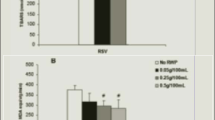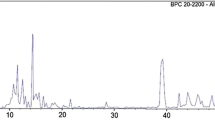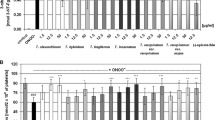Abstract
There is evidence that a diet rich in fruit and vegetables may reduce the risk of cancer and other degenerative diseases. However, potential health impact of bioactive phytochemicals is limited by their low amount and relatively poor bioavailability. It has been suggested that the health benefits associated with fruit and red wine consumption could be due to the whole antioxidant pool of the diet microcomponents. In this study, the antioxidant activities of trans-resveratrol, pterostilbene and quercetin, and the effect of their combination were investigated in human erythrocytes in vitro. H2O2-induced lipid peroxidation was assessed by measuring the amount of thiobarbituric acid reactive species. Quercetin and pterostilbene protected erythrocyte membranes against lipid peroxidation (IC50 values = 64 ± 8.7 µM and 44.5 ± 7.8 µM, respectively). Resveratrol was significantly less effective. However, the three compounds protected the erythocytes against hemolysis and GSH (reduced glutathione) depletion to the same extent. Combinations consisting of two compounds (molar ratio 1:1) influenced lipid peroxidation in a concentration–dependent manner. At lower concentrations, resveratrol with quercetin or pterostilbene inhibited synergistically the oxidative injury of membrane lipids At higher concentrations, an additive effect was observed. These protective effects may partially explain the health benefit of these bioactive microcomponents when together in the diet.



Similar content being viewed by others
Abbreviations
- IC50 :
-
the concentration required to inhibit hemolysis or lipid peroxidation by 50%
- DMSO:
-
dimethyl sulfoxide
- AAPH:
-
2,2′-azobis(2-amidinopropane)hydrochloride
- GSH:
-
reduced glutathione
- TBARS:
-
thiobarbituric acid reactive substances
- CI:
-
combination index
References
Rimm EB, Katan MB, Ascherio A, Stampfer MJ, Willet WC (1996) Relation between intake of flavonoids and risk for coronary heart disease in male health professionals. Ann Intern Med 125:384–389
Szajdek A, Borowska BJ (2008) Bioactive compounds and health-promoting properties of berry fruits: a review. Plant Foods Hum Nutr 63:147–156
Adrian M, Jeandet P, Douillet-Breuil AC, Tesson L, Bessis R (2000) Stilbene content of mature Vitis vinifera berries in response to UV-C elicitation. J Agric Food Chem 48:6103–6105
Kerry NL, Abeby M (1997) Red wine and fractionated phenolic compounds prepared from red wine inhibit low density lipoprotein oxidation in vitro. Atherosclerosis 135:93–102
Ignatowicz E, Balana B, Vulimiri SV, Szaefer H, Baer-Dubowska W (2003) The effect of plant phenolics on the formation of 7, 12-dimethylbenz[a]anthracene-DNA adducts and TPA-stimulated polymorphonuclear neutrophils chemiluminescence in vitro. Toxicology 189:199–209
Rimando AM, Cuendet M, Desmarchelier C, Mehta RG, Pezzuto JM, Duke SO (2002) Cancer chemopreventive and antioxidant activities of pterostilbene, a naturally occurring analogue of resveratrol. J Agric Food Chem 50:3453–3457
Stivala LA, Savio M, Carafoli F, Perucca P, Bianchi L, Maga G, Forti L, Pagnoni UM, Albini A, Prosperi E, Vannini V (2001) Specific structural determinants are responsible for the antioxidant activity and the cell cycle effects of resveratrol. J Biol Chem 276:22586–22594
Williamson G, Barron D, Shimoi K, Terao J (2005) In vitro biological properties of flavonoid conjugates found in vivo. Free Radic Res 39:457–469
Walle T, Hsieh F, DeLegge MH, Oatis JE, Walle UK (2004) High absorption but very low bioavailability of oral resveratrol in humans. Drug Metab Dispos 32:1377–1382
Liu RH (2004) Potential synergy of phytochemicals in cancer prevention: mechanism of action. J Nutr 134:3479S–3485S
Ferrer P, Asensi M, Segarra R, Ortega A, Benlloch M, Obrador E, Varea MT, Asensio G, Jordá L, Estrela JM (2005) Association between pterostilbene and quercetin inhibits metastatic activity of B16 melanoma. Neoplasia 7:37–47
Mertens-Talcott SU, Percival SS (2005) Ellagic acid and quercetin interact synergistically with resveratrol in the induction of apoptosis and cause transient cell cycle arrest in human leukemia cells. Cancer Lett 218:141–151
Yang JY, Della-Fera MA, Rayalam S, Ambati S, Hartzell DL, Park HJ, Baile CA (2008) Enhanced inhibition of adipogenesis and induction of apoptosis in 3T3-L1 adipocytes with combinations of resveratrol and quercetin. Life Sci 82:1032–1039
Elattar TM, Virji AS (1999) The effect of red wine and its components on growth and proliferation of human oral squamous carcinoma cells. Anticancer Res 19:5407–5414
Stagos D, Kazantzoglou G, Theofanidou D, Kakalopoulou G, Magiatis P, Mitaku S, Kouretas D (2006) Activity of grape extracts from Greek varieties of Vitis vinifera against mutagenicity induced by bleomycin and hydrogen peroxide in Salmonella typhimurium strain TA102. Mutat Res 609:165–175
Tedesco I, Russo M, Russo P, Iacomino G, Russo GL, Carraturo A, Faruolo C, Moio L, Palumbo R (2000) Antioxidant effect of red wine polyphenols on red blood cells. J Nutr Biochem 11:114–119
Dise CA, Goodman DBP (1986) t-Butyl hydroperoxide alters fatty acid incorporation into erythrocyte membrane phospholipid. Biochim Biophys Acta 859:69–78
Stocks J, Dormandy TL (1971) Autoxidation of human red cell lipids induced by hydrogen peroxide. Br J Hematol 20:95–111
Chou TC, Talalay P (1984) Quantitative analysis of dose-effect relationships: the combined effects of multiple drugs or enzyme inhibitors. Adv Enzyme Regul 22:27–55
Galati G, Sabzevari O, Wilson JX, O’Brien PJ (2002) Prooxidant activity and cellular effects of the phenoxyl radicals of dietary flavonoids and other polyphenolics. Toxicology 177:91–104
Tavazzi B, Di Pierro D, Amorini AM, Fazzina G, Tuttobene M, Giardina B, Lazzarino G (2000) Energy metabolism and lipid peroxidation of human erythrocytes as a function of increased oxidative stress. Eur J Biochem 267:684–689
Pawlikowska-Pawlęga B, Gruszecki W, Misiak L, Gawron A (2003) The study of the quercetin action on human erythrocyte membranes. Biochem Pharmacol 66:605–612
López-Revuelta A, Sánchez-Gallego JI, Hernández-Hernández A, Sánchez-Yagűe J, Llanillo M (2006) Membrane cholesterol contents influence the protective effects of quercetin and rutin in erythrocytes damaged by oxidative stress. Chem-Biol Interact 161:79–91
Bilto YY, Abdalla SS (1998) Effects of selected flavonoids on deformability, osmotic fragility and aggregation of human erythrocytes. Clin Hemorheol Microcirc 18:165–173
Zhou B, Wu L-M, Yang L, Liu Z-L (2005) Evidence for α-tocopherol regeneration reaction of green tea polyphenols in SDS micelles. Free Radic Biol Med 38:78–84
Upaganlawar A, Gandhi C, Balaraman R (2009) Effect of green tea and vitamin E combination in isoproterenol induced myocardial infarction in rats. Plant Foods Hum Nutr 64:75–80
Fang JG, Lu M, Chen ZH, Zhu HH, Li Y, Yang L, Wu LM, Liu ZL (2002) Antioxidant effects of resveratrol and its analogues against the free-radical-induced peroxidation of linoleic acid in micelles. Chem-Eur J 8:4191–4198
Ferrali M, Signorini C, Caciotti B, Sugherini L, Ciccoli L, Giachetti D, Comporti M (1997) Protection against oxidative damage of erythrocyte membrane by the flavonoid quercetin and its relation to iron chelating activity. FEBS Lett 416:123–129
Belguendouz L, Fremont L, Linard A (1997) Resveratrol inhibits metal ion-dependent and independent peroxidation of porcine low-density lipoproteins. Biochem Pharmacol 53:1347–1355
Tadolini B, Juliano C, Piu L, Franconi F, Cabrini L (2000) Resveratrol inhibition of lipid peroxidation. Free Radic Res 33:105–114
Cheng J-C, Fang J-G, Chen W-F, Zhou B, Yang L, Liu Z-L (2006) Structure-activity relationship studies of resveratrol and its analogues by the reaction kinetics of low density lipoprotein peroxidation. Bioorg Chem 34:142–157
Šavikin K, Zdunić G, Janković T, Tasić S, Menkowić N, Stević T, Dordević B (2009) Phenolic content and radical scavenging capacity of berries and related jams from certificated area in Serbia. Plant Foods Hum Nutr 64:212–217
Pappa G, Strathmann J, Löwinger M, Bartsch H, Gerhäuser C (2007) Quantitative combination effects between sulforaphane and 3, 3′-diidndolylmethane on proliferation of human colon cancer cells in vitro. Carcinogenesis 28:1471–1477
Wallig MA, Heinz-Taheny EDL, Gossman T (2005) Synergy among phytochemicals within crucifers: does it translate into chemoprotection? J Nutr 135:2972S–2977S
Author information
Authors and Affiliations
Corresponding author
Rights and permissions
About this article
Cite this article
Mikstacka, R., Rimando, A.M. & Ignatowicz, E. Antioxidant Effect of trans-Resveratrol, Pterostilbene, Quercetin and Their Combinations in Human Erythrocytes In Vitro . Plant Foods Hum Nutr 65, 57–63 (2010). https://doi.org/10.1007/s11130-010-0154-8
Published:
Issue Date:
DOI: https://doi.org/10.1007/s11130-010-0154-8




